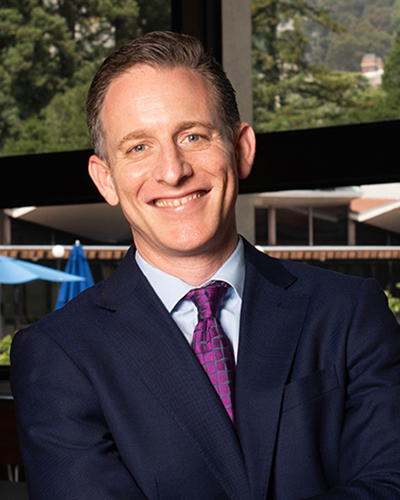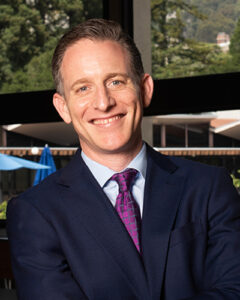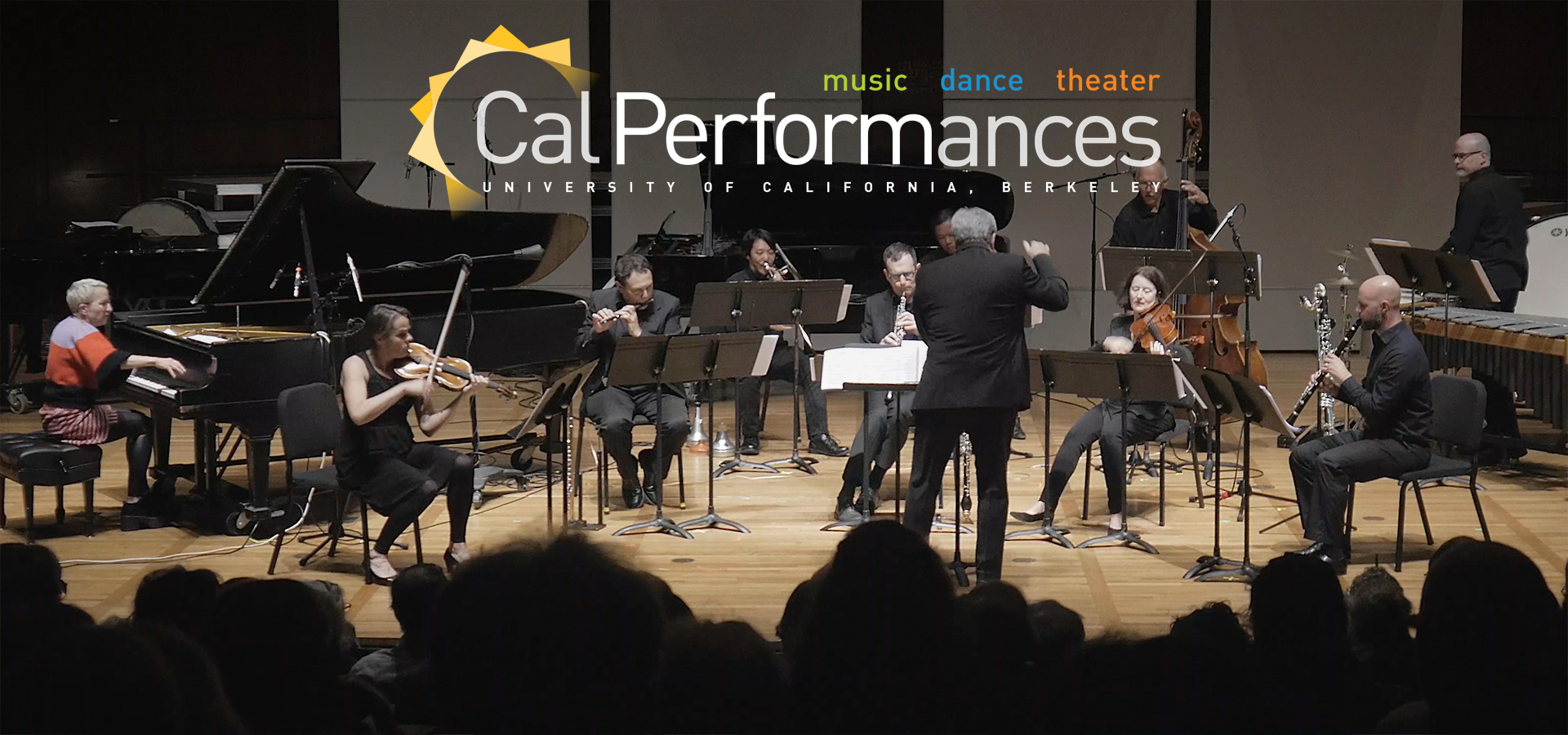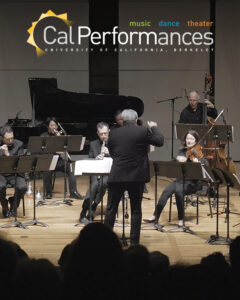Eco Ensemble
David Milnes, conductor
Saturday, February 3, 2024, 8pm
Hertz Hall
Cal Performances is committed to fostering a welcoming, inclusive, and safe environment for all—one that honors our venues as places of respite, openness, and respect.
Please see the Community Agreements section on our Policies webpage for more information.
Run time for this performance is approximately 2 hours including intermission.
From the Executive and Artistic Director

I’m so pleased to welcome you back to campus as we move into the second half of our extraordinary 2023–24 season. There are far too many highlights this month for me to mention each and every one, but I can’t help but single out a few standout events. Of course, any visit by the legendary soprano Renée Fleming is worthy of attention, and this month’s Zellerbach Hall appearance is no exception, coming, as it does, hot on the heels of her receiving the prestigious Kennedy Center Honor for lifetime artistic achievement in December. For dance, you won’t want to miss a dazzling double-bill pairing the late Pina Bausch’s iconic The Rite of Spring with common ground[s], a new duet co-created and performed by septuagenarians Germaine Acogny, known as the “mother of African contemporary dance,” and Malou Airaudo, a longtime dancer with the Tanztheater Wuppertal Pina Bausch. Featuring more than 30 dancers from 14 African countries assembled through a collaboration with Germany’s Pina Bausch Foundation, Senegal’s École des Sables, and the UK’s Sadler’s Wells theater, this program is the type of large-scale and ambitious artistic collaboration that has long defined Cal Performances. And finally, we’re tremendously excited about Taylor Mac & Matt Ray’s upcoming Bark of Millions (see page 6 for more details), an epic “parade trance extravaganza” that celebrates queerness in all its facets and the power of individuality and human connection to push boundaries and bring bold and fresh perspectives to our stage.
As spring approaches, we will continue to invest in ongoing relationships with established and acclaimed artistic partners, with upcoming projects including the renewal of a multi-season residency by The Joffrey Ballet, which this year will present its first full-length narrative ballet, Anna Karenina, at Zellerbach Hall. And I’m especially pleased that in March, the renowned pianist Mitsuko Uchida will join us as Artist in Residence for two special concerts as well as additional opportunities for the campus and wider Bay Area community to engage with her singular artistry.
An ongoing focus of the season is our multi-dimensional Illuminations programming, which once again connects the work of world-class artists to the intellectual life and scholarship at UC Berkeley via performances and public programs investigating a pressing theme—this season, “Individual & Community.” Concepts of “individual” and “community” have been at the forefront of public discourse in recent years, with new questions emerging as to how we can best nurture a sense of community and how the groups we associate with impact our own sense of self. Given our fast-evolving social landscape, how can we retain and celebrate the traits that make each of us unique, while still thriving in a world that demands cooperation and collaboration? With the performing arts serving as our guide and compass, we will explore the tensions that come into play when balancing the interests of the individual with those of the group.
Finally, I want to mention a major new venture coming up next season, the Maria Manetti Shrem and Elizabeth Segerstrom California Orchestra Residency, when Cal Performances and the Philharmonic Society of Orange County will bring the world renowned Vienna Philharmonic and conductor Yannick Nézet-Séguin to California during spring 2025. Made possible by philanthropists Maria Manetti Shrem and Elizabeth Segerstrom, three performances at Zellerbach Hall (March 5–7) will be followed by two in Orange County (March 9 and 11) at the Renée and Henry Segerstrom Concert Hall. Programs will feature works by Mozart, Schubert, Dvořák, Mahler, and Richard Strauss, with acclaimed pianist Yefim Bronfman set to join the orchestra for a Beethoven concerto appearance. Exact programming will be announced shortly, and on-sale dates will be provided in April, when Cal Performances’ 2024–25 season is announced to the general public.
Again, welcome to Cal Performances! We’re delighted to join together, celebrating the very best in live music, dance, and theater.
Jeremy Geffen
Executive and Artistic Director, Cal Performances
 I’m so pleased to welcome you back to campus as we move into the second half of our extraordinary 2023–24 season. There are far too many highlights this month for me to mention each and every one, but I can’t help but single out a few standout events. Of course, any visit by the legendary soprano Renée Fleming is worthy of attention, and this month’s Zellerbach Hall appearance is no exception, coming, as it does, hot on the heels of her receiving the prestigious Kennedy Center Honor for lifetime artistic achievement in December. For dance, you won’t want to miss a dazzling double-bill pairing the late Pina Bausch’s iconic The Rite of Spring with common ground[s], a new duet co-created and performed by septuagenarians Germaine Acogny, known as the “mother of African contemporary dance,” and Malou Airaudo, a longtime dancer with the Tanztheater Wuppertal Pina Bausch. Featuring more than 30 dancers from 14 African countries assembled through a collaboration with Germany’s Pina Bausch Foundation, Senegal’s École des Sables, and the UK’s Sadler’s Wells theater, this program is the type of large-scale and ambitious artistic collaboration that has long defined Cal Performances. And finally, we’re tremendously excited about Taylor Mac & Matt Ray’s upcoming Bark of Millions (see page 6 for more details), an epic “parade trance extravaganza” that celebrates queerness in all its facets and the power of individuality and human connection to push boundaries and bring bold and fresh perspectives to our stage.
I’m so pleased to welcome you back to campus as we move into the second half of our extraordinary 2023–24 season. There are far too many highlights this month for me to mention each and every one, but I can’t help but single out a few standout events. Of course, any visit by the legendary soprano Renée Fleming is worthy of attention, and this month’s Zellerbach Hall appearance is no exception, coming, as it does, hot on the heels of her receiving the prestigious Kennedy Center Honor for lifetime artistic achievement in December. For dance, you won’t want to miss a dazzling double-bill pairing the late Pina Bausch’s iconic The Rite of Spring with common ground[s], a new duet co-created and performed by septuagenarians Germaine Acogny, known as the “mother of African contemporary dance,” and Malou Airaudo, a longtime dancer with the Tanztheater Wuppertal Pina Bausch. Featuring more than 30 dancers from 14 African countries assembled through a collaboration with Germany’s Pina Bausch Foundation, Senegal’s École des Sables, and the UK’s Sadler’s Wells theater, this program is the type of large-scale and ambitious artistic collaboration that has long defined Cal Performances. And finally, we’re tremendously excited about Taylor Mac & Matt Ray’s upcoming Bark of Millions (see page 6 for more details), an epic “parade trance extravaganza” that celebrates queerness in all its facets and the power of individuality and human connection to push boundaries and bring bold and fresh perspectives to our stage.
As spring approaches, we will continue to invest in ongoing relationships with established and acclaimed artistic partners, with upcoming projects including the renewal of a multi-season residency by The Joffrey Ballet, which this year will present its first full-length narrative ballet, Anna Karenina, at Zellerbach Hall. And I’m especially pleased that in March, the renowned pianist Mitsuko Uchida will join us as Artist in Residence for two special concerts as well as additional opportunities for the campus and wider Bay Area community to engage with her singular artistry.
An ongoing focus of the season is our multi-dimensional Illuminations programming, which once again connects the work of world-class artists to the intellectual life and scholarship at UC Berkeley via performances and public programs investigating a pressing theme—this season, “Individual & Community.” Concepts of “individual” and “community” have been at the forefront of public discourse in recent years, with new questions emerging as to how we can best nurture a sense of community and how the groups we associate with impact our own sense of self. Given our fast-evolving social landscape, how can we retain and celebrate the traits that make each of us unique, while still thriving in a world that demands cooperation and collaboration? With the performing arts serving as our guide and compass, we will explore the tensions that come into play when balancing the interests of the individual with those of the group.
Finally, I want to mention a major new venture coming up next season, the Maria Manetti Shrem and Elizabeth Segerstrom California Orchestra Residency, when Cal Performances and the Philharmonic Society of Orange County will bring the world renowned Vienna Philharmonic and conductor Yannick Nézet-Séguin to California during spring 2025. Made possible by philanthropists Maria Manetti Shrem and Elizabeth Segerstrom, three performances at Zellerbach Hall (March 5–7) will be followed by two in Orange County (March 9 and 11) at the Renée and Henry Segerstrom Concert Hall. Programs will feature works by Mozart, Schubert, Dvořák, Mahler, and Richard Strauss, with acclaimed pianist Yefim Bronfman set to join the orchestra for a Beethoven concerto appearance. Exact programming will be announced shortly, and on-sale dates will be provided in April, when Cal Performances’ 2024–25 season is announced to the general public.
Again, welcome to Cal Performances! We’re delighted to join together, celebrating the very best in live music, dance, and theater.
Jeremy Geffen
Executive and Artistic Director, Cal Performances
About the Performance
Cañon (2010) for flute, clarinet/bass clarinet, two bassoons, two trumpets, trombone, and bass trombone
When Ben Simon approached me about composing a new work for the San Francisco Chamber Orchestra, he gave me several choices of “companion” pieces to choose from—works already in the repertoire that would have the same instrumentation as my composition. Somewhat to Ben’s surprise, I chose the Stravinsky Octet, a piece that I’ve loved since encountering it as a student. Having a rather unusual instrumentation, the Octet is not so well known outside of professional circles—but for us composers, it’s a beloved composition, full of energy, charm, and dry wit. If you don’t already know it, you’re in for a treat.
Of course, when I took on this instrumentation, it became filtered through my own creative lens. My sound-world is very different from Stravinsky’s. I love a certain kind of transparency in music, a kind of flow or elegance, but I also prefer the sonic choices to have special or unusual colors. So, for example, I ask the brass players to sing into their instrument while they’re playing or use multiple kinds of mutes to alter the sound. I ask for the wind players to overblow their instrument or to split the airstream to create “multiphonics,” the illusion of chords. I ask the flute player to play “whistle tones”—beautiful, very quiet sounds that for me evoke nature and natural surroundings.
While composing this piece, I had been reading a work of the great naturalist John Muir, The Mountains of California. Even though this book is over 100 years old, his descriptions of our landscape (are they science or poetry?) still resonate—particularly inspiring were passages describing the sculpting process of glaciers and waterways, and these had a direct influence on Cañon. Also influential was a trip I took to the amazing Iguazú falls on the border of Argentina and Brazil. The immensity of the falls is impossible to describe; the wealth of color, the tremendous power and force—these images also formed part of Cañon’s genesis.
[Four Studies of Light and Dark] (1989) for piano and percussion
Written 35 years ago, [Four Studies of Light and Dark] is the oldest work on this evening’s concert and was composed when I was still a graduate student at Indiana University. It was well received at that time and to my bemusement the recording was played widely on jazz radio stations. The piece is structured in ways that are still quite important in my work—there is a “frame” (movements I and VI) that serve as an introduction and postlude surrounding the four studies II-V. (I use brackets in the title to symbolize the first and last framing movements.) The inner studies are organized symmetrically, with II and V illustrating light and dark respectively. Movement II is cast in a high register and is very fast, with a running high piano and xylophone melody that you will recognize again in dance sections of The Road to Xibalba on the second half of the program. Movement V is a complement of II in its low register and likewise fast tempo with fast piano clusters and loud tom-tom drums. The inner Movement III is slow and dark, with a chorale-like chordal melody low in the piano and swirls of tam-tams played with brushes and a bow, and it moves without pause into movement IV, which continues the chorale melody high in the piano with percussion crotales, with bowed suspended cymbals. The odd timbre that is prominent in the piano at the beginning and end of the piece is a dime inserted between the strings of the D-flat just above middle C.
I did quite a bit of performing when I was a graduate student, and my intention with this piece was to write something fun and challenging for myself at the piano and my percussionist friend Kay Stonefelt. Four Studies was originally conceived as a dance piece, with “light” and “dark” symbolically portrayed by two dancers and was choreographed a few years later by the Larry Pech Dance Company.
Hishuk ish ts’awalk [All Things are One] (2014) for clarinet/bass clarinet, violin, viola, cello, and piano
The entwined and enwoven puzzle pieces of my Hishuk ish ts’awalk were inspired by a visit to the wild temperate rainforest in the Pacific Rim National Park Reserve of Canada. To the First Nations people of the Nuu-chah-nulth, the title means “all things are one.” My vision was to create a resonant, forceful, yet fragile musical ecosystem, with a musical space full of echoes, noise, and silence.
The large-scale form is in three parts, separated by pauses. There are two movements in Part One, two movements in Part Two, and one movement to finish, making a total of five movements in the piece. Spatial relationships predominate; you will hear the same music reappear in a different register and moving in a different direction, turned upside down and varying in character and speed.
The resonance of the piano’s sostenuto pedal is employed throughout Part One and Part Three, against clarinet subtones, and special bowings, harmonics, and swaying double stops in the strings. The clarinet solo at the end of Part One, with its interposed noisy multiphonics, descends to complete movement two, and is complemented by the rising cello solo at the beginning of Part Three. The center of the piece, Part Two, features a silvery and lilting unison line that loops around on itself in the third movement. A contrasting and complementing palindrome, the fourth movement rises with forceful, loud snaps in the strings, slaps in the bass clarinet, and a huge culmination and climax of everyone to the top. In Part Three, the opening music returns, with piano resonance, trembling strings, and the disembodied clarinet sounds.
Scenes from The Road to Xibalba (2023, World Premiere) for narrator, four singers, large chamber ensemble, and field recordings
The Road to Xibalba’s story is drawn from the great ancient Maya text, The Popol Vuh. Poet John Campion developed the English libretto for The Road from his own translation of the larger work. The Popol Vuh is a creation myth according to the K’iche’ Maya people in what is now Guatemala. The text is an ancient account of their origins and cosmology in a world before the coming of Westerners and Christianity. In the early 1700s, a Dominican friar named Francisco Ximénez recorded a transliterated K’iche’ text (in a phonetic script with Latin characters) parallel to a Spanish translation (considered the oldest known version of The Popol Vuh).
The Road to Xibalba outlines the exploits of Maya “hero twins” who go down to the underworld to play a ball game with the Lords of Death, and in defeating them affirm the eternal cycle of life. It is a tale full of whimsy, pathos, and timely ecological reflections. There is a humorous cast of animal characters and charmed figures that ultimately point to a higher relation of cosmological order and spiritual connectedness.
In preparation for this piece, Campion and Cox researched the written materials and visited scores of Maya archeology sites and museums in Mexico, Guatemala, and Honduras. Among many others, these included Chichen Itza, Tulum, Palenque, Uxmal, Tikal, and Copan.
SYNOPSIS
Tonight we present eight scenes in a concert version drawn from the four-act musical theater work that will ultimately include a chorus and dancers. The scenes tonight mostly come from the first half of The Road to Xibalba. Each scene opens with a field recording of sounds from Central American birds and wildlife, and roughly follows the 20-day Maya cycle.
The presentation opens with an introduction by the Narrator, who serves multiple roles as a poet, a jokester, and an intimate informer. In the second scene, we meet Little Blood, daughter of the fearsome Lords of Death in Xibalba, the underworld. In the forbidden garden, she encounters a skull in a tree that she mistakes for a squash. This skull originally belonged to one of the sons of grandmother Xmucane. He had been called One Hunahpu and was murdered along with his twin (Seven Hunahpu) by the Lords of Death after the boys lost a ball game. Following a very humorous verbal exchange, the skull of One Hunahpu spits into Little Blood’s hand and makes her pregnant with twins. In the third scene, the Lords of Death are very angry when they find out about Little Blood’s pregnancy. For punishment, they send a messenger owl to kill her, with explicit instructions to return with her heart as proof the deed was done. Little Blood manages to evade being killed with some clever talk and by providing the owl the red sap from a copal tree that she shaped into a heart. The sap, she convinces the owl, is red like a heart and will burn sweet as incense. The owl agrees and takes the sap back to the Lords and fools them completely.
In the fourth scene, Little Blood flees Xibalba, goes to live with grandmother Xmucane, and gives birth to the hero twins Hunahpu and Xbalanque. The fifth scene five opens with Hunahpu and Xbalanque working in the field. They hide themselves to find out just who has been eating all their produce—which is how they catch the Rat. In exchange for his freedom, the Rat confesses that grandmother Xmucane has deceived the twins into believing they are farmers, when in fact they were born to be ball players, just like their fathers One Hunahpu and Seven Hunahpu, who were killed in Xibalba. He shows them where the ball-playing equipment is hidden and the twins joyously play a game. In the sixth scene, the Lords in the underworld hear the ball playing and send for the twins to come to Xibalba. In the ninth scene, the twins say a tearful goodbye to their mother Little Blood (now called Blood Woman) and grandmother Xmucane, and leave for Xibalba. In the final scene this evening, Hunahpu and Xbalanque, having shown that death is not the end but part of the cycle of life, enact a ritual invoking the breath and spirit encircling the world.
—Cindy Cox



